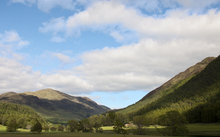Glen Lyon

Glen Lyon(Scottish Gaelic:Gleann Lìomhann) is aglenin thePerth and Kinrossregion ofScotland.It is the longest enclosed glen in Scotland and runs for 34 miles (55 kilometres) fromLoch Lyonin the west to the village ofFortingallin the east.
This glen was also known asAn Crom Ghleann( "The Bent Glen" ). The land given over to the MacGregors wasAn Tòiseachd.It forms part of theLoch Rannoch and Glen Lyon National Scenic Area,one of forty such areas in Scotland, which are defined so as to identify areas of exceptional scenery and to ensure its protection from inappropriate development by restricting certain forms of development.[1]SirWalter Scottdescribed Glen Lyon as the "longest, loneliest and loveliest glen in Scotland".[2]Apart from a few scattered farms and cottages throughout the glen, the only real settlements are atFortingallandBridge of Balgie.
The glen contains several small hamlets and has a primary school where Gaelic is taught weekly.
History
[edit]
Quite densely inhabited from prehistoric times (as many archaeological sites attest), although its present population is of modest size, the glen has been home to manyScottish clans,includingClan MacGregor,[3]Lyon, Menzies, Stewart, Macnaughtan, MacGibbon and the Campbell lairds of Glen Lyon.
At the end of the 11th century the de Leons (later shortened to "Lyon" ) had come north withPrince Edgar,son ofMalcolm III of Scotlandto fight against his uncle,Donald Bane.Edgar was victorious and the de Leons received lands that were later called Glen Lyon in Perthshire.[4][5][6][7]LocalTacksmanRobert Campbell of Glenlyon(1630–1696), led the troops of theEarl of Argyll's Regiment of Footduring their involvement in theinfamous massacreof theMacDonaldsatGlencoein 1691. A magnificent silver-giltbroochset with precious stones belonging to the Campbell lairds of Glen Lyon (that has been dated to the early 16th century) is currently in theBritish Museum.[8]
Glen Lyon, also written Glenlyon, has been the home of (among others)early Christianmonks(includingAdomnán[locally Eonán] (died 704), Abbot ofIonaandbiographerofSt Columba). It contains at least twocastles:Meggernie Castle[still inhabited] and Carnbane Castle [ruined].[9]
Their history is described in Alexander Stewart'sA Highland Parish(1928), and Duncan Campbell'sThe Lairds of Glenlyon(1886).
Notable people
[edit]- Isobel Forresteran ecumenist was born at Glenlyon manse in 1895.[10]
- Fr. James MacGregor (Scottish Gaelic:Maighstir Seumas MacGriogair), parish priest of Fortingall for theCatholic Church in Scotlandduring the early16th-century,compiled theBook of the Dean of Lismore,the most important surviving manuscript collection ofmedievalScottish Gaelic literature.HisChronicle,covering local events in a mixture ofMiddle ScotsandEcclesiastical Latin,is also still extant, and is an important historical source for the centralHighlands.
- Watson Kirkconnell(1895 -1977), a Canadian poet andpublic intellectualof proudly HighlandScottish descent,explored the legacy of his Glen Lyon ancestors in his memoirs.
Gallery
[edit]-
River Lyon
-
Cattle in Glen Lyon
References
[edit]- ^"National Scenic Areas".Scottish Natural Heritage.Retrieved17 January2018.
- ^Jen Benson; Sim Benson (17 May 2018).The Adventurer's Guide to Britain: 150 incredible experiences on land and water.Bloomsbury Publishing. p. 20.ISBN978-1-84486-520-8.Retrieved24 July2018.
- ^Gibson, John Graham (2002).Old and New World Highland Bagpiping.McGill-Queen's Press - MQUP. p. 22.ISBN9780773522916.Retrieved14 December2017.
- ^Herald, Ross (1911)."Lyon, Earl of Strathmore and Kinghorne".Scotts Peerage:1.
- ^Anderson, W (1862). "The Story of the Family Lyon".The Scottish Nation.3.
- ^"The Story of the Family Lyon".Some Old World Lyons– via The American Lyon Association.
- ^Thomson, Ingrid, Glamis Castle Archivist
- ^British Museum Collection
- ^Carnbane Castle and a banquet for a bard
- ^Matthew, H. C. G.; Harrison, B., eds. (23 September 2004),"The Oxford Dictionary of National Biography",Isobel Forrester,Oxford: Oxford University Press,doi:10.1093/ref:odnb/66407,retrieved5 June2023


